
* Boeing was not satisfied with the second generation of the 737, moving on to the "737 New Generation" in the 1990s, with improved CFM56 engines and a redesigned wing. The company is now producing the fourth generation, the "737 MAX" series.
Although the 737 was purchased mostly by commercial airlines, it was also obtained by military forces -- not just as transports but for other roles, such as the US Air Force "T-43A" navigation trainer, based on the 737-200. The US Navy and a number of American allies went on to obtain the "P-8 Poseidon" maritime patrol aircraft, based on the 737. This chapter discusses the third and fourth generation 737s, as well as specific military variants.
* Even as the second-generation Boeing 737s were becoming established in service, Boeing officials were considering a third generation to keep up with aggressive competition, as well as replace the Boeing 727 trijet -- the Boeing 757 had been supposed to do that job, but it ended up appealing to a slightly different market. In 1993, the company kicked off the "Next Generation 737-X" program. As the program emerged, the 737 NG machines shared several significant improvements:
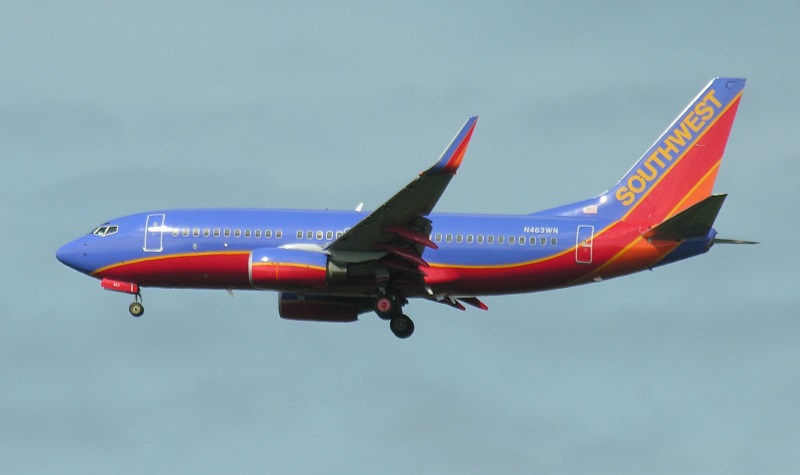
Four basic 737 NG variants were built. The first to fly was the "737-700", originally "737-300X", which was to replace the 737-300 and could be fitted with a maximum of 149 seats. Initial flight was on 9 February 1997, aircrew being Mike Hewett and Ken Higgins. Certification and initial deliveries took place later in that year. It would lead to specialized subvariants, see below.
___________________________________________________________________
BOEING 737-700:
___________________________________________________________________
wingspan:
34.31 meters (112 feet 7 inches)
wingspan (winglets):
35.79 meters (117 feet 5 inches)
wing area:
125 sq_meters (1,345.5 sq_feet)
length:
33.63 meters (110 feet 4 inches)
height:
12.57 meters (41 feet 3 inches)
empty weight:
38,145 kilograms (84,100 pounds)
MTO weight:
70,080 kilograms (154,500 pounds)
max speed at altitude:
1,015 KPH (630 MPH / 550 KT)
cruise altitude:
12,500 meters (41,000 feet)
range, full load:
2,850 kilometers (1,770 MI / 1,540 NMI)
___________________________________________________________________
The second was the "737-800", originally "737-400X Stretch". It had a length of 39.47 meters (129 feet 6 inches) and a maximum capacity of 189 seats. Initial flight was on 31 July 1997, with introduction to service in the spring of 1998.
The "737-600", originally "737-500X", was the third, intended to replace the 737-500. It had a length of 31.24 meters (102 feet 6 inches) and a maximum capacity of 132 seats. Initial flight was on 22 February 1998, with introduction to service before the end of the year. Incidentally, Boeing never offered winglets as a purchase option on the 737-600.
The fourth, the "737-900", didn't fly until 3 August 2000, with introduction to service in the spring of 2001. It was the biggest 737 built to that time, with a length of 42.11 meters (138 feet 1 inch) and a maximum capacity of 215 seats -- well more than the 189 seats of the 727-200, the irony being that the 737, originally designed as a "baby brother" to the 727, ended up a bigger aircraft.
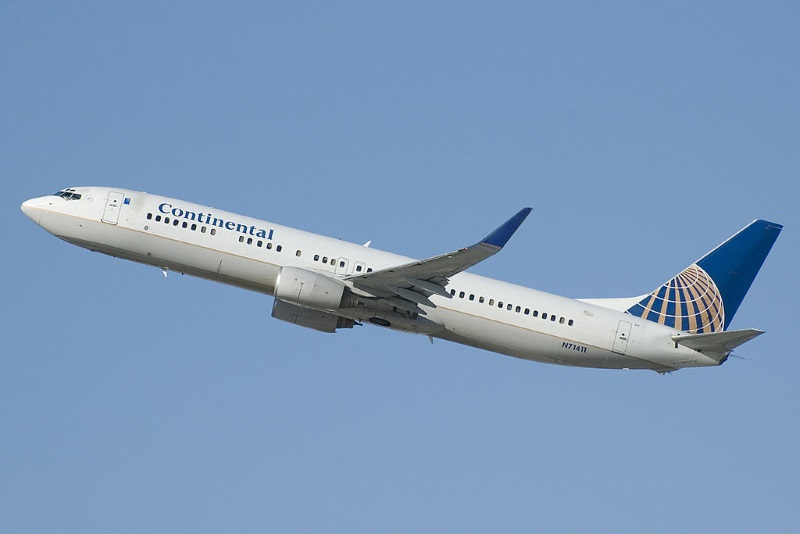
Actually, at the outset the 737-900 could only carry a maximum of 189 passengers due to regulatory issues. It led to "737-900ER", introduced in 2007, which could handle a full 215 passengers, thanks to the addition of two more emergency exits. The 737-900ER could also be obtained retaining the maximum of 189 seats and without the additional emergency exits, but with additional tankage for improved range. Of course, the airframe was reinforced to handle higher MTO weight.
* From 1996, Boeing began work on an increased growth weight "737-700IGW" which was actually a hybrid, effectively a 737-700 with the stronger wing and landing gear of the 737-800, permitting additional fuel tankage and special equipment fits. The primary initial motivation of this exercise was the "Boeing Business Jet (BBJ)" version of the 737, intended for the executive-VIP market. It proved surprisingly popular.
The 737-700IGW airframe also led to the "737-700C" and "737-700QC" combi freighter aircraft; and then the extended-range "737-700ER", featuring additional fuel tankage. It had a range of 10,200 kilometers (6,335 miles / 5,510 NMI), about twice the range of the baseline 737-700. It could be configured for 48 seats in a premium configuration, or up to 126 seats in a traditional two-class configuration. Deliveries began in 2007. Boeing also introduced a "BBJ2", based on the 737-800, and the "BBJ3", based on the 737-900ER, with a cargo door as an option.
With a new generation of 737s coming online -- see immediately below -- the 737 NG series is now faced with gradual obsolescence. As a result, Boeing has been promoting a "737-800 Boeing Converted Freighter" -- with cargo door, reinforced floor, and other freighter kit -- the initial redelivery of a 737-800BCF taking place in 2018. Aftermarket vendors have offered similar conversions.
BACK_TO_TOP* By the 21st century, the 737 was one of the world's most successful airliners. In 2005, one in four of the world's large airliners were 737s; 6,100 had been ordered in total, with more than 4,100 in service with over 400 airlines; and over a thousand were in the air at any one time. Of all the commercial jetliners sold by Boeing and Douglas, a good third of them were 737s. Ironically, the 737's old rival, the DC-9, had evolved through the acquisition of McDonnell Douglas by Boeing into the "Boeing 717", and then had ceased production.
Late in the first decade of the 21st century, Boeing was focused on development of the "787" advanced technology twinjet, leveraging off 787 technology to also update the 747 jumbo jet to the "747-8". The company had considered development of an all-new replacement for the 737 -- but given customer satisfaction with the 737 and a short-term demand for something better, Boeing decided to give the 737 a 787-flavored facelift as well.
Rival Airbus had been similarly considering a new-design replacement for its competing A320, but decided to introduce an updated version, the "A320 New Engine Option (NEO)", instead, with delivery from 2015. Boeing couldn't afford to leave the field to Airbus over the longer interval it would have taken to develop a new machine that could only be an incremental improvement over an updated one -- and so decided to have the next-generation "737 MAX" flying by 2016, and in the hands of airlines by 2017.
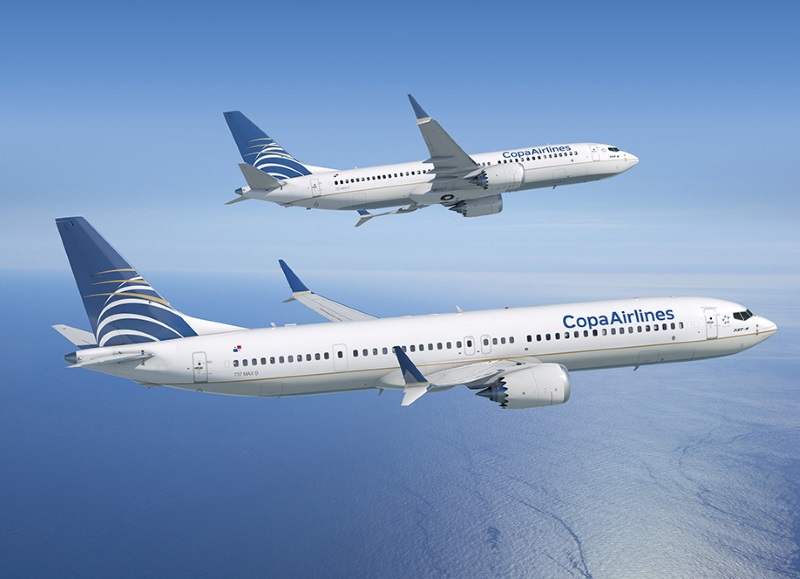
At the outset, Boeing planned three models of the fourth-generation 737 MAX: the "737 MAX 7", "737 MAX 8", and "737 MAX 9" -- updates of the 737-700, 737-800, and 737-900 respectively, all of similar configuration, but with different capacities. They were all to be offered in Boeing Business Jet configurations. The company claimed the new machines would be 10% to 12% more fuel-efficient than the previous generation of 737s. Of course, it was fuel efficiency that was pushing the upgrade; jetliners burn a lot of fuel, and as expensive as it is to buy a new jetliner, it's too expensive to fly an old one that guzzles fuel.
The core of the upgrade was a new engine, the CFM International "LEAP-1B". The LEAP-1B had a diameter of 175 centimeters (69 inches) as opposed to the 157 centimeters (62 inches) of the CFM56. That required stretching the 737's nose gear by 20 centimeters (6 to 8 inches) to clear taxiway lighting; the configuration of electronic gear in the nose had to be rearranged to accommodate the longer nose gear. The engines had the distinctive serrated cowlings introduced on the 787 to reduce noise.
Airframe changes to the 737 MAX series were to be minimal -- no major changes of airframe elements from metal to composite materials, no new wing, though an extended tailcone and twin-fin ("dual feather") winglets were fitted. Since third-generation 737s already had a glass cockpit, there was no need to do much more there than update to current technology. Boeing also decided to leverage off the "Boeing Sky" interior developed for the 787, featuring:
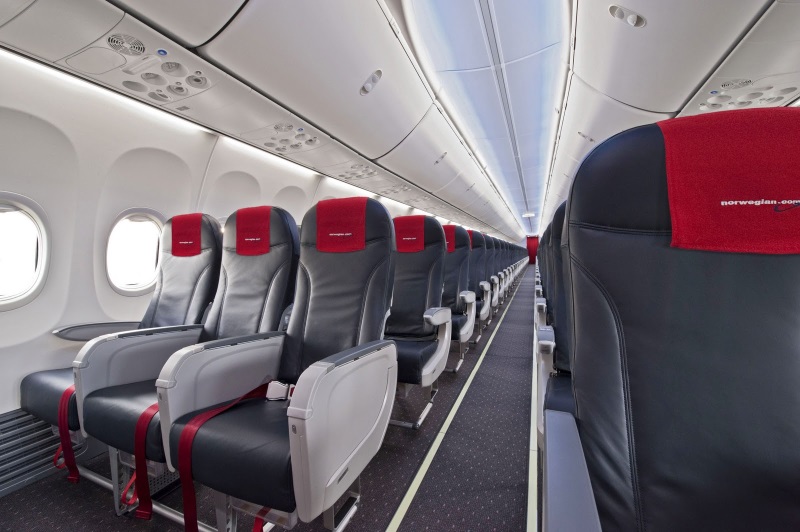
The Boeing Sky interior was also made available as an option on 737 NG machines and has proven popular. It could not be retrofitted to earlier machines, but third parties did offer retrofits with some of the functionality.
In the design of the 737 MAX, Boeing was very leery of "feature creep", the unpleasant tendency of "modest updates" to become comprehensive redesigns. However, it's hard to resist; in 2016, in response to customer feedback, Boeing announced that it had stretched the 737 MAX 7 relative to the 737-700 to add two more rows of seats, with plugs fore and aft of the wings to increase length to 35.56 meters (116 feet 8 inches) -- providing 172 seats in an all-economy configuration and 138 in a two-class configuration.
With the greater seat capacity, two emergency exits were fitted over each wing instead of one; given the greater take-off weight, the 737 MAX 7 was given the MAX 8's wings and landing gear. Nonetheless, there was otherwise no basic change in configuration. Indeed, the 737 MAX noticeably retained a feature distinctive to all 737s from the beginning of its service: there were still no main gear doors.
* Initial flight of the first 737 MAX prototype, a 737 MAX 8, was on 30 January 2016, with three more prototypes following later. Initial deliveries to customers were in the spring of 2017, Boeing having moved up the schedule as much as possible to deal with A320NEO competition. Boeing also decided to offer a high-density "sardine can" version of the 737 MAX 8, named the "737 MAX 200", in 2019, this model featuring another exit door to cope with the greater passenger load. Initial flight of the first of two 737 MAX 9 prototypes was on 13 April 2017. Initial deliveries to customers were in early 2018. First flight of the 737 MAX 7 was on 16 March 2018, with introduction to service in 2019.
At the 2017 Paris Air Show, Boeing had introduced another MAX variant, the 737 MAX 10" -- originally "737-10X" -- to counter the stretched Airbus A321NEO. The 737 MAX 10 was stretched 1.67 meters (66 inches) relative to the 737 MAX 9, for a length of 43.8 meters (143 feet 8 inches). It was designed for 230 seats in a single-class configuration, and 189 seats in a dual-class configuration. It was also to feature updated avionics, more electrical power generation systems, next-generation composite wings, and updated LEAP-1B turbofans.
However, schedule for 737 MAX 10 introduction was delayed by events. On 29 October 2018, a 737 MAX 8 of Lion Air crashed after departure from Jakarta, Indonesia, with all 189 on board killed. This was the first fatal accident of the 737 MAX. That was bad, but jetliners do crash every now and then, and that doesn't necessarily indicate an inherent problem with a particular design. Unfortunately, on 10 March 2019, an Ethiopian Airlines 737 MAX 8 flying out of Addis Ababa crashed as well, with all 157 on board killed.
The entire 737 MAX fleet was promptly grounded worldwide. Suspicion fell on the aircraft's "Maneuvering Characteristics Augmentation System (MCAS)", which was a flight control software system. Further investigation showed that the 737 MAX had a number of other deficiencies -- and regulators were highly critical of Boeing's flawed design processes, as well as an inclination to cover up problems. The 737 MAX suffered the longest grounding ever, not returning to flight service until late 2020, in the USA, and early 2021 elsewhere.
Boeing's company culture had been in obvious decline, apparently because the management was no longer tuned to aircraft design, and saw engineers as discardable and replaceable. The company, along with losses from the grounding of the aircraft, had to pay tens of billions of dollars in fines and other penalties, with CEO Dennis Muilenberg forced to resign. To make matters worse for the company, the global COVID-19 pandemic brutally affected the commercial aviation industry, with aircraft sales largely in suspension. The pandemic faded out slowly from mid-2021, with Boeing's business recovering, though the company had suffered severely. First flight of the MAX 10 was on 18 June 2021, with initial deliveries expected in 2026, following significant delays.
BACK_TO_TOP* Boeing's successful 737-200 attracted military attention from early on, with the US Air Force (USAF) obtaining 19 "T-43A" navigation trainers in 1973 and 1974. They had workstations and facilities for twelve student navigators, four advanced students, and three instructors, with the floor reinforced to handle the training gear. There were five periscopic portholes in the roof for sextant sightings; the T-43As also had an auxiliary fuel tank for extended range. They looked pretty much like stock 737-200s externally, except for a reduced number of windows and more antennas cluttering up their lines. These aircraft were known as "Gators", it seems not because of anything reptilian in their appearance, but because they trained "(navi)gators". Nobody ever accused the military of having an overly subtle sense of humor.
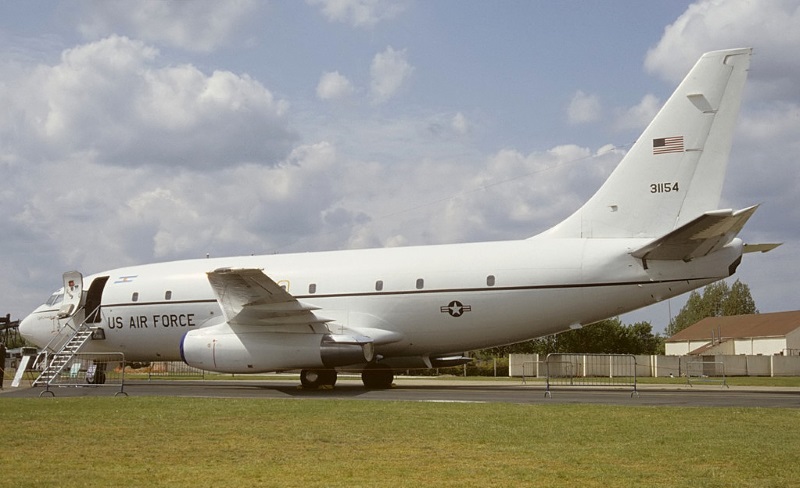
Six were reconfigured to a staff / command transport configuration as the "CT-43A" -- one being lost in a high-profile crash in Croatia on 3 April 1996 that killed all on board, including US Commerce Secretary Ron Brown. The aircraft flew into a mountain while coming in to land at Dubrovnik airport; investigation concluded it was due to flight crew error, the crew not being familiar with the relatively antique approach procedures at Dubrovnik, along with foul weather contributing to the accident.
The CT-43As were retired in 2001, being replaced by the C-37, a variant of the Gulfstream V business jet. The last T-43As were retired in 2010, being replaced by ground simulators, backed up by flight training in T-1A Jayhawks -- military conversions of the Raytheon Hawker 400 business jet. However, one is still flying as the "NT-43A", a T-43A refitted with radomes fore and aft, operating as a test system to evaluate "stealthy" aircraft in flight. It also features sensors, presumably infrared imagers, on top of the nose and tail radomes. The aircraft went into service in its new form in 2001.
Not much is known about the NT-43A -- known as "RAT55" from its radio callsign -- since it supports secret development programs. It is rather elderly now, and there are hints of a replacement in the works.
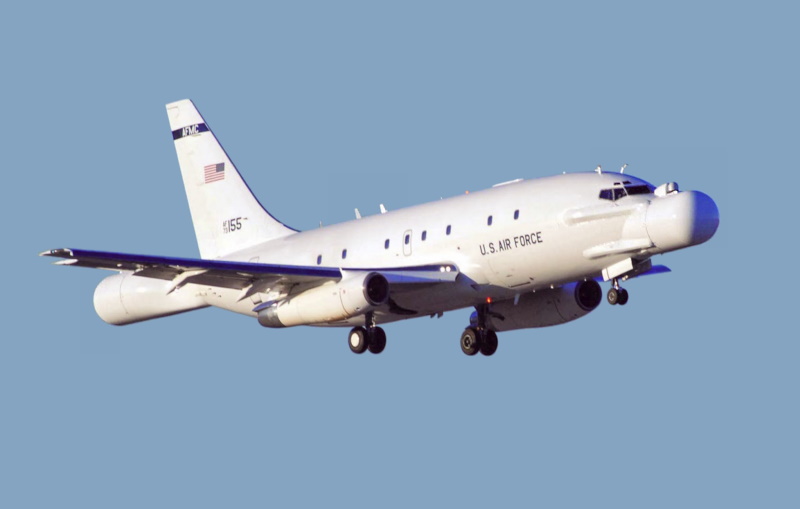
Other 737-200s have been used for electronics test and trials platforms, one being used by the Elta division of Israel Aircraft Industries for various equipment fits, and another given a "nose job" by Boeing to test gear for the USAF's F-35 Joint Strike Fighter (JSF).
* The only other 737-200 machines built as distinctly military platforms were three "727-2N3 Surveiller" maritime patrol aircraft sold to the Indonesian Air Force in the early 1980s. They looked exactly like stock 737-200s, except for twin strakelike 5-meter (16 foot 5 inch) antenna fairings for the Motorola "AN/APS-135(V) Side-Looking Airborne Multi-Mission Radar (SLAMMR)" on top of the rear fuselage, flanking the tailfin.
The SLAMMR system was capable of picking up small ocean craft from a range of up to 160 kilometers (100 miles) while the aircraft was flying at cruise altitude. It does not appear that the Surveillers had many other optimizations for the maritime patrol role, though they may have been also fitted with signals intelligence (SIGINT) gear; in fact, they could still be used as personnel transports with 92 seats. They remain in service at last notice; they were given equipment updates in the early 1990s, and may have received further updates later.
Incidentally, the Indonesian Air Force also obtained several 737-200 (and 737-400) machines as VIP / personnel transports. A fair number of 737-200s were flown as VIP / personnel transports in service with military forces in nations around the world, somewhat surprising users including India and Iran.
BACK_TO_TOP* The US military went on to obtain CFM-powered 737s. Both the US Navy (USN) and the USAF were interested in the 737-700 BBJ, with both services obtaining the type as the "C-40 Clipper". The Navy initially ordered a total of twelve "C-40A" machines, which were in a "combi" configuration, featuring the large cargo door on the left forward side of the fuselage, plus an interior that could be reconfigured to haul 121 passengers, or eight cargo pallets with a total load weight of 18,140 kilograms (40,000 pounds), or a mix -- 70 passengers and three cargo pallets, for example.
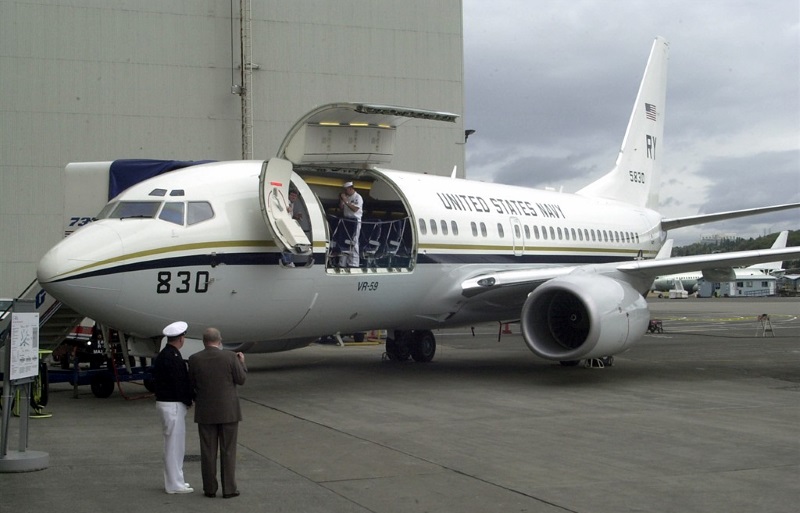
Early C-40A deliveries did not have winglets; later deliveries did, with winglets retrofitted to the earlier aircraft. Deliveries were from 2001 to 2011; they were obtained for the Naval Reserve and were intended to replace C-9B (DC-9) transports. The Navy later obtained more, for a total of 17, with two also obtained by the Marines. The C-9Bs were retired in 2014.
The Air Force's "C-40B", in contrast, was obtained as a VIP transport, lacking the cargo door, being intended for transport of high US military and government officials. It was built to carry 11 crew and 26 passengers in relatively luxurious accommodations, including a crew rest area, VIP compartment with sleep accommodations -- two galleys, and a "business class" section with worktables. It also featured a high-bandwidth secure global communications system and auxiliary fuel tanks. A total of four were obtained. Some of the early deliveries didn't have winglets, but they were upgraded with them later.
In addition, the Air Force obtained "C-40C" combi machines, essentially the same as Navy C-40A aircraft, with seven acquired. While it can be hard to spot the front cargo door in pictures of the C-40C, it is easy to tell it from the C-40B, since the C-40B had a clutter of antennas on its fuselage to support its advanced communications systems, as well a distinctive antenna fairing on top of the tailfin. All C-40Cs were delivered with winglets.
* Armed forces of several nations have acquired CFM-powered 737s as VIP / personnel transports, sometimes with additional communications and self-defense kit. There's a tale that the USAF obtained a 737-800-based VIP transport, but it is difficult to find any details or a US military designation for this machine; the Royal Saudi Air Force did obtain a 737-800-based VIP transport, and the USAF may have been acting as an "agent" for the Saudis in its purchase.
There have been some special-mission conversions of CFM-powered 737s. In 2010, a 737-300 was observed at a Chinese air show with a set of antenna fairings top and bottom. It was said by authorities to be one of two machines obtained second-hand from Garuda Indonesia and converted into missile tracking platforms. Details were not forthcoming. There were tales of other Chinese special-mission conversions of the 737-300, such as an "airborne command post", but they may have been just garbled reads of reports about the missile tracking aircraft.
* One of the most sophisticated militarized 737 variants to be introduced was the "Wedgetail" early warning aircraft, more formally known as the "737 Airborne Early Warning & Control (AEW&C)" or "E-7A", the informal name being in honor of the Australian wedgetail eagle. Boeing's earlier 707-based E-3 Airborne Warning & Control System (AWACS) had established itself as the AEW&C solution for Western military forces, but by the 21st century, it was increasingly dated, and Boeing sought a more modern solution. The result, the E-7A, was a 737-700 BBJ airframe, fitted with a Northrop Grumman "Multirole Electronically Scanned Array (MESA)" radar system, derived from the AN/APG-77 radar built for the Lockheed Martin F-22 fighter.
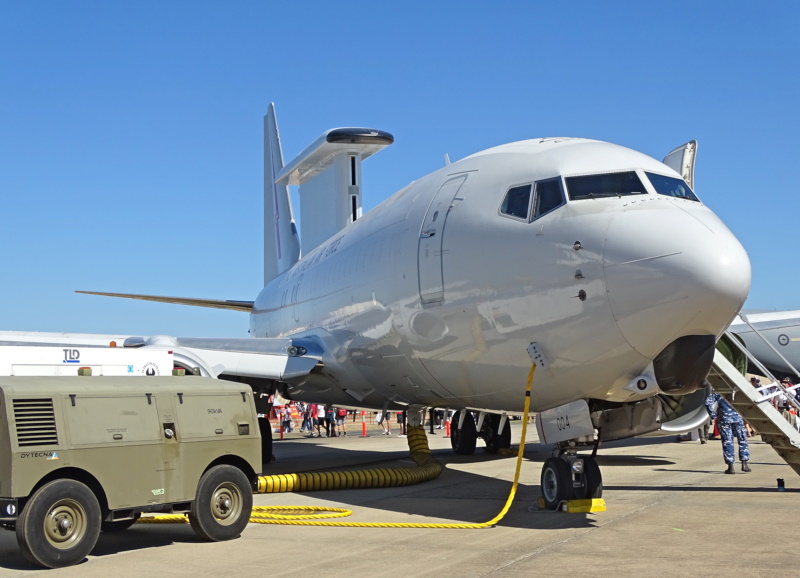
The MESA was based on an "active array" of 280 transmitter-receiver (T/R) elements, mounted in a surfboard-like radome on a pedestal mounted on the aircraft's spine. The T/R elements were each like a radar unto itself; they could be individually programmed to allow the array to perform different functions -- not just radar, but also communications, electronic intelligence, and electronic countermeasures. Multiple functions could be performed at the same time by allocating different parts of the array to different functions.
The MESA operated in the L-band, with a somewhat longer wavelength than the X-band often used in search radars; that gave it lower resolution but better range, better resistance to weather conditions, and the ability to penetrate light foliage. It could provide 360-degree coverage, with instantaneous electronic switching between targets. It could track thousands of aircraft or ships simultaneously out to a radius of 350 kilometers (190 nautical miles), and focus a directed beam towards a specific target beyond 740 kilometers (400 nautical miles).
The E-737 was also fitted with a sophisticated command & communications system, plus a defensive countermeasures suite -- featuring an "electronic support measures (ESM / radio targeting)" system. Unlike the earlier E-3, it did not require an "identification friend or foe (IFF)" system, since the MESA performed that function. Initial test flights were in 2005. Australia, the lead buyer, obtained six, with deliveries in 2006:2008. Further sales followed:
Qatar planned to order three, but decided not to proceed with the deal. In 2022, the US Air Force announced that the service was funding the development of an enhanced version of the E-7 to replace the existing USAF E-3C Sentry AEW platform, with a total buy of 26 envisioned and deliveries no earlier than 2027.
BACK_TO_TOP* The US Navy also acquired a highly sophisticated maritime patrol aircraft based on the 737, the "P-8 Poseidon". During much of the Cold War, the mainstay of ocean defense of the West was the Lockheed P-3C Orion, a four-turboprop maritime patrol aircraft. The Orion was built in large quantities and not only used by the US Navy (USN) but by many American allies. By the end of the 20th century, however, the Orion was beginning to show its age, and the USN began to cast about for a replacement. After a frustrating search, in 2004 the USN finally awarded a contract to Boeing for the "P-8A Poseidon Multimission Maritime Aircraft (MMA)".
As introduced, the P-8A was a heavily militarized 737, based on the fuselage of the 737-800 fitted to the wing and landing gear of the 737-900ER. It was clearly a weapon system, with a weapons bay in the fuselage for homing torpedoes and depth charges; four underwing pylons for Harpoon antiship missiles or other stores; two discreet stations on the forward fuselage for mounting mission equipment; and a rotary dispenser for up to 126 sonar buoys ("sonobuoys"), or stores designed to the sonobuoy form factor.
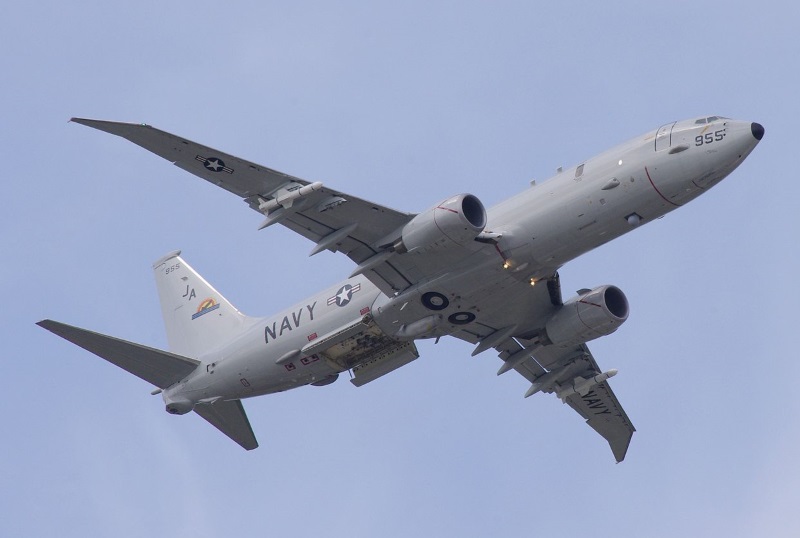
The primary combat avionics sensor was the Raytheon AN/APY-10 radar system, installed in the nose. The AN/APY-10 was a multi-mode search radar, with a "synthetic aperture radar (SAR)" capability for detection, imaging, classification, and identification of large or stationary vessels or for ground surveillance. The radar also featured an "inverse SAR (ISAR)" capability to characterize small or fast moving vessels; had wide-area and high-resolution "spotlight" modes; and possessed passive signals intelligence (SIGINT) capabilities, allowing it to detect, characterize, and locate a wide range of radio or radar "emitters". In addition, the P-8A carried an electro-optical / infrared camera turret for visual inspection of targets.
Other avionics included a GPS / inertial navigation system unit; a suite of communications gear for voice and datalink using direct transmission or satcom relay; and a self-defense suite, including a radar warning system, a heat-seeking missile dazzler, and towed decoys to divert radar-guided missiles. Crew included pilot and copilot, plus five or six mission crew.
* Two static-test prototypes and three flight prototypes were ordered at the outset, the first making its initial flight on 25 April 2009. Three more flight prototypes were ordered later. Introduction to operational service was declared on 1 July 2013, with operational flights taking place before the end of the year.
Orion crews were glad to get their hands on the Poseidon, not least because it was a nicer ride: the Orion tended to fly rough and noisy, while the P-8A had the smooth quiet flight of a jetliner, an important consideration when flying long and tiring patrols. Cockpit crew liked the glass cockpit, though they said it didn't really make life much easier for them, because the Poseidon had more functional capability than the Orion -- like running faster to stay in the same place. Fuel burn of the P-8A was greater than that of the P-3C down low, but the fact that the P-8A could get to station faster compensated for that drawback; the P-8A had a higher ceiling, giving a bigger patrol "footprint". Landing roll was somewhat longer, the P-8A's thrust reversers not being as effective as the P-3C's reversible props.
The "tactical coordinators (TACCO)" also liked the aircraft's "Mission Computing & Display System (MCDS)", which allowed them to display overlaid data from the aircraft's sensors and remote datalinked systems on the twin 61-centimeter (24-inch) displays of each TACCO workstation. The MCDS provided an annotated view of the battlespace, integrating inputs from up to 64 sonobuoys along with radar and video. The system included a reference library to provide useful information on identified targets, as well as a stores menu to allow the TACCOs to select stores for deployment or launch. The TACCOs also could communicate with other platforms over secure comlinks, including access to and control over drones.
The P-8A was designed with upgrades in mind, with software being upgraded every few years to add fixes, enhancements, and support new hardware. The aircraft was designed to provide 50% more power and cooling capability than needed at introduction, and being able to carry almost 11 tonnes (12 tons) more payload.
* In 2009, the P-8A was selected by the Indian Navy as the "P-8I", with India acquiring eight machines, the first being delivered in late 2012, the last in 2015. Four more were ordered in 2016, followed by ten more in 2019. They were much the same as the US Navy P-8As, though with some Indian-specified avionics factored in, including a tail radar and a magnetic anomaly detector. They were delivered without secure communications and electronic warfare systems, India not being cleared for them at the time. India also obtained the Harpoon anti-ship missile and US torpedoes to arm their P-8Is. India was a high-profile sale for Boeing, since traditionally India has bought little military hardware from the USA.
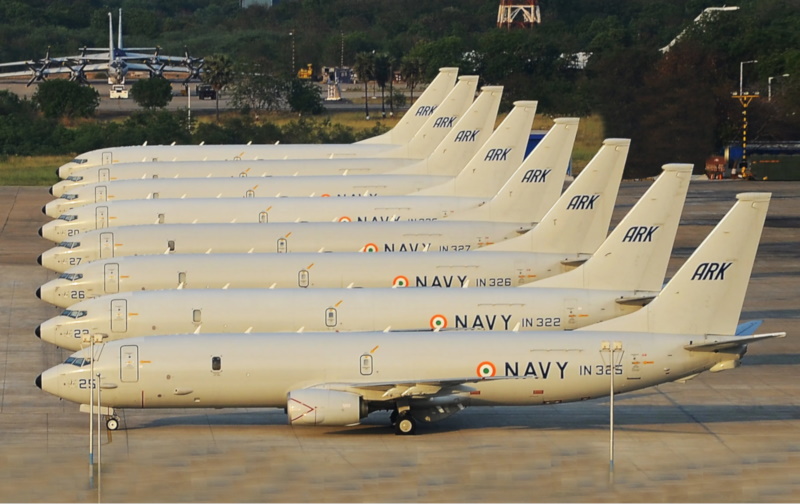
Other nations acquired the P-8A:
Further foreign sales were put in question by the US presidential election of 2024, with incoming President Donald Trump denouncing and bullying traditional American allies, while aligning with Russia. Trump particularly targeted Canada, even threatening to annex it to the US, with the Canadian and German orders seen as at risk.
* The US Navy received its 112th P-8A in the summer of 2022, towards a total of 128. An "Increment 2" upgrade to the P-8A was introduced from 2016. The heart of the upgrade was the Raytheon "Advanced Airborne Sensor (AAS)", an active array radar system derived from the AN/APS-149 Littoral Surveillance Radar (LSRS) carried on some Navy P-3C Orions, and featuring a range of sophisticated surface surveillance modes. The AAS was fitted in a long ventral canoe, carried under the forward fuselage; it turns out that the selection of the 737-800 as the basis for the Poseidon was driven by the length of the canoe.
An inflight refueling capability, using boom refueling, was introduced into service in 2018. All the machines were built with a refueling socket, but inflight refueling hadn't been qualified. An "Increment 3" was introduced from 2020, featuring support for new weapons, networking capabilities, and a smarter battle management system. The EO-IR turret was updated; such turrets are modular, to a degree standardized, and relatively easy to swap out.
One particularly interesting munition, the Boeing "High-Altitude Anti-Submarine Warfare Weapon Capability (HAAWC)" glide torpedo, was introduced as a P-8 store in 2022. The HAAWC was a Mark 54 homing torpedo, fitted to a switchblade airframe derived from that Boeing developed for the Small Diameter Bomb GPS-guided weapon. HAAWC allowed the Poseidon to perform attacks on adversary submarines, and possibly surface vessels, from high altitude and long stand-off distance, with the switchblade airframe delivering the torpedo to the vicinity of the target, then deploying it with a parachute.
The primary rationale for HAAWC was that it reduced the transit time and fuel burn required for the P-8 to descend, drop a torpedo, and then return to cruise altitude. That was not only more economical in terms of fuel, it also meant less stress on the airframe and a longer service life. There was also consideration of an expendable drone that would be launched out of a sonobuoy tube, to deploy wings and fly low to a target area to give it a close-up inspection with an imager and magnetic anomaly detector -- as well as larger drones that could be carried in the weapons bay. However, for now drone carriage remains a future option.
In 2021, Boeing demonstrated a multi-role belly pod for the P-8A, carried on a forward fuselage station. The pod was designed to be readily configured with a wide range of mission equipment. BAE Systems of the UK was awarded a contract in 2024 for an "Intrepid Shield" defensive countermeasures pod for the P-8A; it is not clear when it will be fielded.
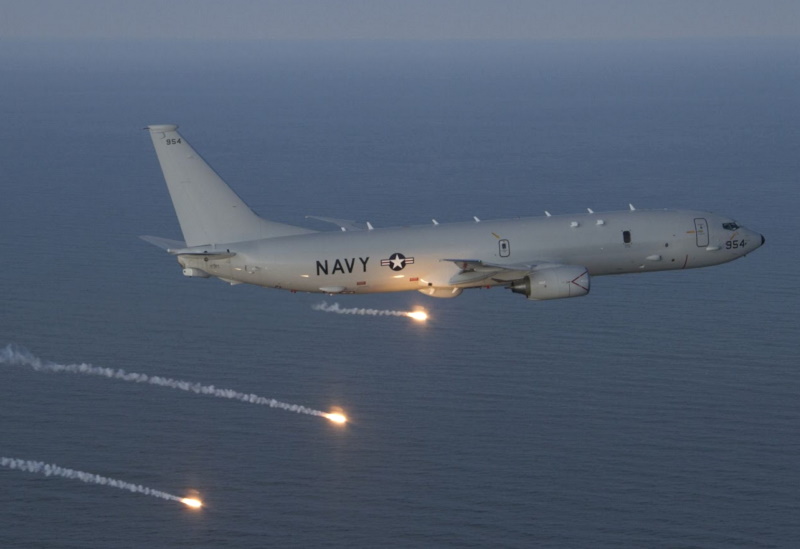
Boeing made suggestions about offering a "Medium-Sized Maritime Surveillance Aircraft" based on the P-8A, presumably based on a smaller 737 variant with a subset of the P-8A's capability. Nobody seemed interested. Similarly, in 2006 the Navy began a search for a replacement for their airborne electronic intelligence (ELINT) platform, the EP-3E Aries, which was much like the P-3C except for payload. Boeing came up with notional designs for the "EP-X", based like the P-8A on the Boeing 737 -- but in 2010, the Navy announced the replacement would be the Northrop Grumman MQ-4C Triton long-endurance drone, carrying a SIGINT payload.
Incidentally, when news of China's conversions of 737s to missile tracking platforms broke, there was some fussing in the defense blogosphere about the negligence of the USA in allowing China to use an American jetliner for military purposes, and for the fact that these Chinese special-mission platforms were in service so much more quickly than the P-8A.
It was a tempest in a teacup. The US government has little control over old jetliners sold on the international market, and comparing the Chinese conversions to the P-8A was like comparing a car given an updated sound system to one converted into an armored battle wagon. The conversions were no more challenging than that applied to the NT-43A; the Chinese could have used a wide range of older aircraft, it was just a question of installing special-purpose kit in some airframe that could truck it around. The P-8A, in contrast, is an optimized weapon system integrating a suite of sensors, armament, communications gear, and self-defense systems. Whatever problems have afflicted the P-8A program, it's in a different league.
BACK_TO_TOP* The following list gives baseline 737 variants, including length in meters and maximum passenger capacity for comparison:
By the beginning of 2025, almost 12,000 737s had been built.
* Investigating the 737 led me to finally dig into something that had been puzzling me for a long time: the difference between a leading-edge slat and a leading-edge flap. I was half-tempted to think they were just different names for the same thing, but since the 737 had both leading-edge slats and leading-edge flaps, that couldn't be the case.
It took some poking around since the topic is not well documented -- even when it's discussed, it's not always discussed very clearly -- but the two technologies are distinct. Some short take-off aircraft have "slots", which are fixed narrow airfoils mounted directly ahead of the wing, their function being to direct airflow over the wing at low speeds. Slots are draggy, however, and not useful for high-performance aircraft, and so machines like the 737 have "slats", which are essentially retractable slots. Sometimes slots are called "fixed slats".
Leading-edge flaps, in contrast, are essentially like trailing-edge flaps, surfaces which are turned downwards to increase wing curvature for improved low-speed handling. There are different approaches to leading-edge flaps, one being a "drooping" leading edge flap -- just like it says, it's hinged at the rear and drops down to increase lift. The "Krueger flap" on the 737 is a little less intuitive, being something like a door hinged on the leading edge of the wing. For take-offs and landings, a Krueger flap essentially "flips over", going from being closed under the leading edge of the wing to open forward into the airstream, the rear edge of the "door" then becoming the front edge. It looks a little awkward, but it works just fine. No doubt there are other variations on leading-edge flight surfaces, but trying to figure out that much was enough of a pain.
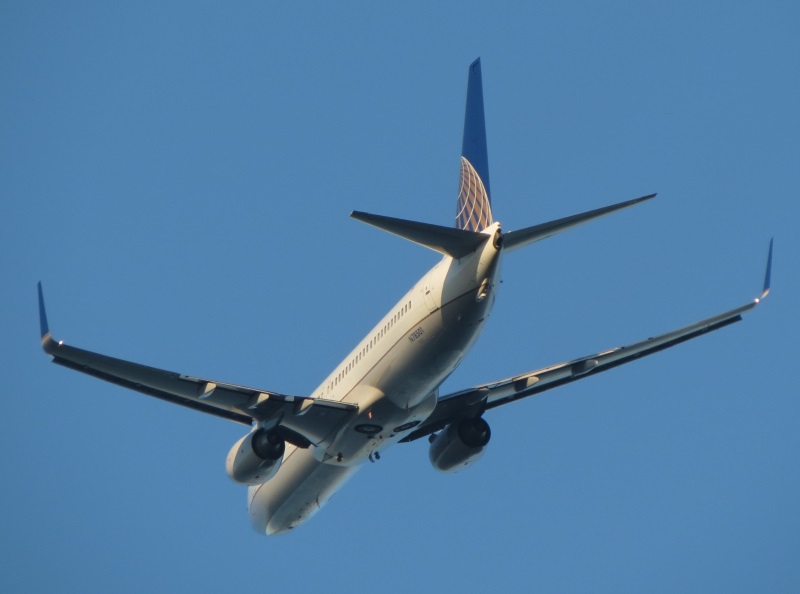
* Sources include:
Of course, various volumes of JANE'S ALL THE WORLD'S AIRCRAFT were consulted for details. Wikipedia has some fair to good articles on the 737, and the "737 Technical Site" had some interesting materials as well. YouTube also turned out to be a useful resource, with videos showing how slats and Krueger flaps actually worked. Pictures are worth a thousand words; videos are worth a hundred pictures.
* Illustration credits:
* Revision history:
v1.0.0 / 01 feb 12 v1.0.1 / 01 jan 14 / Aussie P-8A buy, cleanups. v1.1.0 / 01 dec 15 / 9,000 737s, Qatar Wedgetail order. v1.2.0 / 01 nov 17 / More on 737 MAX, P-8, ETC. v1.3.0 / 01 oct 19 / 737 MAX grounding, P-8, ETC. v1.4.0 / 01 mar 21 / Review & polish. v1.5.0 / 01 jul 21 / General update. v1.6.0 / 01 may 23 / Review, update, & polish. v1.6.1 / 01 apr 25 / Review, & polish. (+)BACK_TO_TOP
